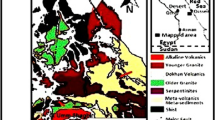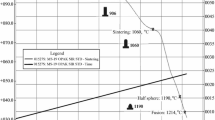Abstract
Thermal analyses are suitable methods when studying not only nowadays, but also archaeological ceramic materials. In this case, they were used to study the mineralogical composition and the ageing process of a collection of fragments of Gothic mosaic tiles which were found during archaeological research of Břevnov Benedictine Monastery in Prague. The ceramic bodies of the tiles were differently coloured and showed different degrees of degradation. The ageing process of low-fired ceramics is accompanied by irreversible moisture expansion of a ceramic body which can lead to its degradation. The expansion of ceramic bodies of selected tiles was evaluated by the modified dilatation method. Thermal analyses with the combination of other methods (XRF, XRD and IR) and induced hydrothermal treatment proved the presence of clays in raw materials and helped to identify the causes of different degrees of degradation of the studied tiles.












Similar content being viewed by others
References
Hanykýř V, Kloužková A, Bouška P, Vokáč M. Ageing of historical ceramics. Acta Geodyn Geomater. 2009;6(1):59–66.
Hanykýř V, Kloužková A, Bouška P, Vokáč M. Stárnutí pórovitého keramického střepu. Sborník ze semináře Objemové změny pórovité keramiky. Praha: Silikátový svaz, 2009, 33–43.
Vokáč M, Kloužková A, Hanykýř V, Bouška P. Dilatometric analysis of ceramic roof tiles for determining irreversible moisture expansion. Ceramics-Silikáty. 2009;53(4):303–9.
Savage SD, Wilson MA, Carter MA, KcKay B, Hoff WD. Mass gain due to the chemical recombination of water in fired clay brick. J Am Ceram Soc. 2008;91(10):3396–8.
Drelich J, Bowen PK, Scarlett TJ. Effect of humidity instability on rehydroxylation in fired clay ceramics. J Am Ceram Soc. 2013;96(4):1047–50.
Shoval S. Rehydroxylation of clay minerals and hydration in ancient pottery from the ´Land of Geshur´. J Therm Anal. 1991;37:1579–92.
Burakov KS, Nachasova IS. Archaeomagnetic study and rehydroxylation dating of fired clay ceramics. Izv-Phys Solid Earth. 2013;49(1):111–9.
Moinester M, Piasetzky E, Braverman M. RHX dating of archaeological ceramics via a new method to determine effective lifetime temperature. J Am Ceram Soc. 2015;98(3):913–9.
Schurecht HG. Methods for testing crazing of glazes caused by increases in size of ceramic bodies. J Am Ceram Soc. 1928;11:271–7.
Bouška P, Hanykýř V, Vokáč M, Pume D. Failures of floor structures made from concrete and fired clay units. In: Proceedings of construction materials’05 and Mindess Symposium. The University of British Columbia, Vancouver 2005, 1711–20.
Hauck D, Hilker E. Moisture expansion behaviour of brick. Ziegelindustrie-Jahrbuch: Bauverlag Wiesbaden; 1989.
Albenque M. Action de la vapeur d´eau sur les silicates ayant pris naissance à la cuision de pâtes céramiques. Dissertation thesis. Universite de Paris VI, 1974.
Pavlovic LJ, Tosic M. Kinetics of moisture expansion in some fired clay bricks. Tile Brick Int. 1997;13(2):105–9.
ČSN EN 772-19. Methods of test for masonry units—part 19: determination of moisture expansion of large horizontally perforated clay masonry units. Prague: Český normalizační institut, 2000. p. 12.
ČSN EN ISO 10545-10. Ceramic tiles—part 10: determination of moisture expansion. Prague: Český normalizační institut, 1998. p. 8.
AS/NZS 4456.11. Standard, masonry units and segmental pavers—methods of test. Method 11: Determining coefficients of expansion. Australian/New Zealand: Standards Australia, 1997. p. 12.
NF P 13–302. Entrevous en terre cuite pour planchers a poutrelles préfabriquées, Paris: AFN, 1983. p. 26.
Kloužková A, Zemenová P, Kohoutková M, Mazač Z. Ageing of fired-clay ceramics: comparative study of rehydroxylation processes in a kaolinitic raw material and moon-shaped ceramic idol from the Bronze Age. Appl Clay Sci. 2016;119(2):358–64.
Kloužková A, Zemenová P, Kohoutková M, Kloužek J. Hydrothermal rehydroxylation of kaolinite studied by thermal analysis. Ceramics-Silikáty. 2013;57(4):342–7.
Zemenová P, Kloužková A, Kohoutková M, Král R. Investigation of the first and second dehydroxylation of kaolinite. J Therm Anal Calorim. 2014;116:633–9.
Kloužková A, Zemenová P, Kohoutková M, Mazač Z. Characterisation of a prehistorical ceramic object: moon-shaped idol, by means of thermal analysis. J Therm Anal Calorim. 2014;116:641–5.
Quinn PS. Ceramic petrography. The interpretation of archaeological pottery & related artefacts. In Thin Section. Oxford: Archaeopress; 2013.
Reedy C. Thin-section petrography of stone and ceramic cultural materials. London: Archetype Books; 2008.
Dragoun Z. Středověké podlahy a dlaždice z břevnovského kláštera. Zprávy památkové péče. 1993;53(5):170–6.
Dragoun Z, Tryml M, Mjartan J. Restaurování torz středověkých podlah z Dolních Chaber a Břevnovského kláštera. Staletá Praha. 2010;26(2):122–9.
Rovnaníková P. Omítky: Chemické a technologické vlastnosti. Praha: STOP; 2002.
Rosen OM, Abbyasov AA, Tipper JC. MINLITH–an experience-based algorithm for estimating the likely mineralogical compositions of sedimentary rocks from bulk chemical analyses. Comput Geosci UK. 2004;30:647–61.
Gregerová M, Čopjaková R, Beránková V, Bibr P, Goš V, Hanuláková D, Hložek M, Holubová Závodná B, Kristová L, Kuljovská Z, Macháček J, Mazuch M, Procházka R, Škoda R, Všianský D. Petroarcheologie keramiky v historické minulosti Moravy a Slezska. 1. vyd. Brno: Masarykova univerzita, 2010.
Adams AE. Mackenzie WS, Guilford C. Atlas of sedimentary rocks under the microscope. Essex: Longman Scientific & Technical; 1984.
Vaculíková L, Plevová E, Vallová S, Koutník I. Characterization and differentiation of kaolinites from selected Czech deposits using infrared spectroscopy and differential thermal analysis. Acta Geodyn Geomater. 2011;8(1):59–67.
Madejová J, Komadel P. Baseline studies of the clay minerals society source clays: infrared methods. Clay Clay Miner. 2001;49(5):410–32.
Acknowledgements
This work was financially supported by specific university research (MSMT No 20/2015).
Author information
Authors and Affiliations
Corresponding author
Rights and permissions
About this article
Cite this article
Kloužková, A., Kavanová, M., Kohoutková, M. et al. Identification of causes of degradation of Gothic ceramic tiles by thermal analyses. J Therm Anal Calorim 125, 1311–1318 (2016). https://doi.org/10.1007/s10973-016-5488-5
Received:
Accepted:
Published:
Issue Date:
DOI: https://doi.org/10.1007/s10973-016-5488-5




